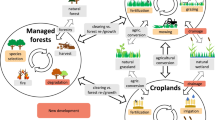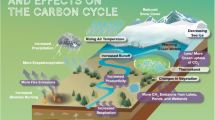Abstract
The Met Office Hadley Centre Unified Model (HadAM3) with the tiled version of the Met Office Surface Exchange Scheme (MOSES2) land surface scheme is used to assess the impact of a comprehensive imposed vegetation annual cycle on global climate and hydrology. Two 25-year numerical experiments are completed: the first with structural vegetation characteristics (Leaf Area Index, LAI, canopy height, canopy water capacity, canopy heat capacity, albedo) held at annual mean values, the second with realistic seasonally varying vegetation characteristics. It is found that the seasonalities of latent heat flux and surface temperature are widely affected. The difference in latent heat flux between experiments is proportional to the difference in LAI. Summer growing season surface temperatures are between 1 and 4 K lower in the phenology experiment over a majority of grid points with a significant vegetation annual cycle. During winter, midlatitude surface temperatures are also cooler due to brighter surface albedo over low LAI surfaces whereas during the dry season in the tropics, characterized by dormant vegetation, surface temperatures are slightly warmer due to reduced transpiration. Precipitation is not as systematically affected as surface temperature by a vegetation annual cycle, but enhanced growing season precipitation rates are seen in regions where the latent heat flux (evaporation) difference is large. Differences between experiments in evapotranspiration, soil moisture storage, the timing of soil thaw, and canopy interception generate regional perturbations to surface and sub-surface runoff annual cycles in the model.












Similar content being viewed by others
References
Avissar R, Pielke RA (1991) The impact of plant stomatal control on mesoscale atmospheric circulations. Agr For Meteorol 54: 353–372
Betts AK, Ball JH, Beljaars ACN (1993) Comparison between the land surface response of the ECMWF model and the FIFE-1987 data. Q J R Meteorol Soc 119: 975–1001
Betts RA (2000) Offset of the potential carbon sink from boreal forestation by decreases in surface albedo. Nature 408: 187–190
Bounoua L, Collatz GJ, Los SO, Sellers PJ, Dazlich DA, Tucker CJ, Randall DA (2000) Sensitivity of climate to changes in NDVI. J Clim 13: 2277–2292
Buermann W, Dong J, Zeng X, Myneni RB, Dickinson RE (2001) Evaluation of the utility of satellite-based vegetation leaf area index data for climate simulations. J Clim 14: 3536–3550
Charney JG (1975) Dynamics of desert and drought in the Sahel. Q J R Meteorol Soc 101: 193–202
Cox PM, Huntingford C, Harding RJ (1998) A canopy conductance and photosynthesis model for use in a GCM land surface scheme. J Hydrol 212–213: 79–94
Dirmeyer PA (1994) Vegetation stress as a feedback mechanism in midlatitude drought. J Clim 7: 1463–1483
Freedman JM, Fitzjarrald DR, Moore KE, Sakai RK (2001) Boundary layer clouds and vegetation–atmosphere feedbacks. J Clim 14: 180–197
Gedney N, Cox PM, Douville H, Polcher J, Valdes PJ (2000) Characterizing GCM land surface schemes to understand their responses to climate change. J Clim 13: 3066–3079
Henderson-Sellers A, Dickinson RE, Durbridge TB, Kennedy PJ, McGuffie K, Pitman AJ (1993) Tropical deforestation: modeling local- and regional-scale climate change. J Geophys Res 98(D4): 7289–7315
Kim J, Verma S (1990) Components of surface energy balance in a temperate grassland ecosystem. Bound Layer Meteorol 51: 401–417
Koster RD, Dirmeyer PA, Hahmann AN, Ijpelaar R, Tyahla L, Cox P, Suarez MJ (2002) Comparing the degree of land–atmosphere interaction in four atmospheric general circulation models. J Hydrometeorol 3: 363–375
Lawrence DM, Slingo JM (2003) An annual cycle of vegetation in a GCM. Part I: implementation and impact on evaporation. Clim Dyn (in press)
Los SO, Collatz GJ, Sellers PJ, Malmstrom CM, Pollack NH, De Fries RS, Bounoua L, Parris MT, Tucker CJ, Dazlich DA (2000) A global 9-yr biophysical land surface dataset from NOAA AVHRR data. J Hydrometeorol 1: 183–199
Los SO, Collatz GJ, Bounoua L, Sellers PJ, Tucker CJ (2001) Global interannual variations in sea surface temperature and land surface vegetation, air temperature, and precipitation. J Clim 14: 1535–1549
Lu L, Shuttleworth WJ (2002) Incorporating NDVI-derived LAI into the climate version of RAMS and its impact on regional climate. J Hydrometorol 3: 347–362
Lu L, Pielke RA, Liston GE, Parton WJ, Ojima D, Hartman M (2001) Implementation of a two-way interactive atmospheric and ecological model and its application to the central United States. J Clim 14: 900–919
Moore KE, Fitzjarrald KR, Sakai RK, Goulden ML, Munger JW, Wofsy SC (1996) Seasonal variation in radiative and turbulent exchange at a deciduous forest in central Massachusetts. J Appl Meteorol 35: 122–134
Pope VD, Gallani ML, Rowntree PR, Stratton RA (2000) The impact of new physical parametrizations in the Hadley Centre climate model: HadAM3. Clim Dyn 16: 123–146
Schulze ED, Kelliher RM, Körner C, Lloyd J, Leuning R (1994) Relationships among maximum stomatal conductance, ecosystem surface conductance, carbon assimilation rate, and plant nitrogen nutrition. Annu Rev Ecol Syst 25: 629–660
Schwartz MD (1996) Examining the spring discontinuity in daily temperature ranges. J Clim 9: 803–808
Schwartz MD (1992) Phenology and springtime surface-layer change. Mon Weather Rev 120: 2570–2578
Taylor CM, Clark DB (2001) The diurnal cycle and African easterly waves: a land surface perspective. Q J R Meteorol Soc 127: 845–867
Trenberth KE, Guillemot CJ (1996) Physical proceses involved in the 1988 drought and 1993 floods in North America. J Clim 9: 1288–1298
Tsvetsinskaya EA, Mearns LO, Easterling WE (2001a) Investigating the effect of seasonal plant growth and development in three-dimensional atmospheric simulations. Part I: simulation of surface fluxes over the growing season. J Clim 14: 692–709
Tsvetsinskaya EA, Mearns LO, Easterling WE (2001b) Investigating the effect of seasonal plant growth and development in three-dimensional atmospheric simulations. Part II: atmospheric response to crop growth and development. J Clim 14: 711–728
van den Hurk BJJM, Viterbo P, Los SO (2003) Impact of leaf area index seasonality on the land surface evaporation in a general circulation model. J Geophys Res 108: 4191–4201
Xie P, Arkin PA (1996) Analyses of global monthly precipitation using gauge observations, satellite estimates and numerical model predictions. J Clim 9: 840–858
Zeng N, Dickinson RE, Zeng X (1996) Climatic impact of amazon deforestation – a mechanistic model study. J Clim 9: 859–883
Zheng X, Eltahir EAB (1998) The role of vegetation in the dynamics of West African monsoons. J Clim 11: 2078–2096
Acknowledgements.
This work was supported through the EU PROMISE project (EVK2-CT-1999-00022). The LAI data was provided as part of the ISLSCP II initiative through NASA Goddard DAAC (Hall, F.G., B. Meeson, S. Los, L. Steyaert, E. Brown de Colstoun, D. Landis, eds. ISLSCP Initiative II. NASA. DVD/CD-ROM. NASA, 2003). We thank Dr. P. Cox, Dr. R. Betts, Dr. C. Taylor and T. Osborne for valuable discussions regarding this work. The authors would also like to thank the anonymous reviewers for their constructive comments, which improved the quality of the study.
Author information
Authors and Affiliations
Corresponding author
Rights and permissions
About this article
Cite this article
Lawrence, D.M., Slingo, J.M. An annual cycle of vegetation in a GCM. Part II: global impacts on climate and hydrology. Climate Dynamics 22, 107–122 (2004). https://doi.org/10.1007/s00382-003-0367-8
Received:
Accepted:
Published:
Issue Date:
DOI: https://doi.org/10.1007/s00382-003-0367-8




